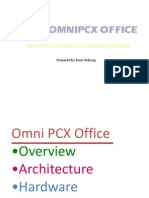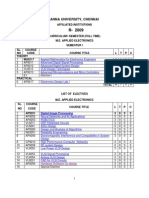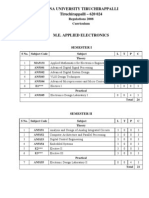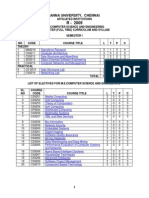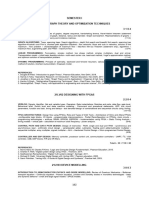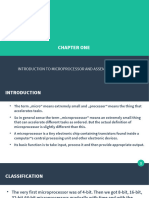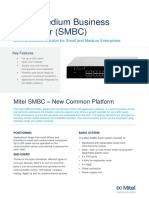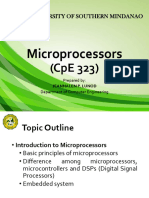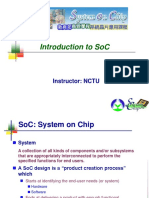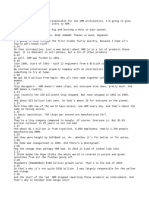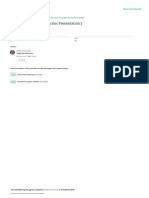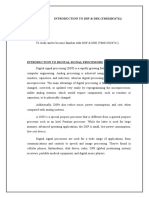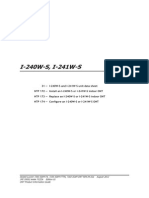VLSI
VLSI
Uploaded by
Moulana YasinCopyright:
Available Formats
VLSI
VLSI
Uploaded by
Moulana YasinCopyright
Available Formats
Share this document
Did you find this document useful?
Is this content inappropriate?
Copyright:
Available Formats
VLSI
VLSI
Uploaded by
Moulana YasinCopyright:
Available Formats
ANNA UNIVERSITY, CHENNAI
AFFILIATED INSTITUTIONS
R - 2009
CURRICULUM I SEMESTER (FULL TIME) M.E. VLSI DESIGN SEMESTER I SL. COURSE NO CODE THEORY MA9217 1 2 VL 9211 3 AP9212 4 VL9212 5 VL9213 6 E1 PRACTICAL 7 VL9217 COURSE TITLE L T P C
Applied Mathematics for Electronics Engineers DSP Integrated Circuits Advanced Digital System Design VLSI Design Techniques Solid State Device Modeling and Simulation Elective I VLSI Design Lab I TOTAL
3 3 3 3 3 3 0 18
1 0 0 0 0 0 0 1
0 0 0 0 0 0 4 4
4 3 3 3 3 3 2 21
LIST OF ELECTIVES M.E. VLSI DESIGN SL. NO 1 2 3 4 5 6 7 8 9 10 11 12 13 14 15 16 17 COURSE CODE VL9251 VL9252 VL9253 VL9254 VL9255 VL9256 VL9257 VL9258 AP9213 AP9252 VL9261 NE9251 AP9256 VL9264 VL9265 VL9266 COURSE TITLE Testing of VLSI Circuits Low Power VLSI Design VLSI Signal Processing Analog VLSI Design Design of Semiconductor Memories VLSI Technology Physical Design of VLSI Circuits Genetic Algorithms and their Applications Advanced Microprocessors and Microcontrollers Neural Networks and Its Applications ASIC Design Reliability Engineering Electromagnetic Interference and Compatibility in System Design Digital Speech Signal Processing DSP Processor Architecture and programming Introduction to MEMS System Design Special Elective L 3 3 3 3 3 3 3 3 3 3 3 3 3 3 3 3 3 T 0 0 0 0 0 0 0 0 0 0 0 0 0 0 0 0 0 P 0 0 0 0 0 0 0 0 0 0 0 0 0 0 0 0 0 C 3 3 3 3 3 3 3 3 3 3 3 3 3 3 3 3 3
MA9217
APPLIED MATHEMATICS FOR ELECTRONICS ENGINEERS
LT P C 3104 12
UNIT I FUZZY LOGIC Classical logic Multivalued logics Fuzzy propositions Fuzzy quantifiers.
UNIT II MATRIX THEORY 12 Some important matrix factorizations The Cholesky decomposition QR factorization Least squares method Singular value decomposition - Toeplitz matrices and some applications. UNIT III ONE DIMENSIONAL RANDOM VARIABLES 12 Random variables - Probability function moments moment generating functions and their properties Binomial, Poisson, Geometric, Uniform, Exponential, Gamma and Normal distributions Function of a Random Variable. UNIT IV DYNAMIC PROGRAMMING 12 Dynamic programming Principle of optimality Forward and backward recursion Applications of dynamic programming Problem of dimensionality. UNIT V QUEUEING MODELS 12 Poisson Process Markovian queues Single and Multi-server Models Littles formula - Machine Interference Model Steady State analysis Self Service queue. L = 45: T=15, TOTAL: 60 PERIODS REFERENCES 1. George J. Klir and Yuan, B., Fuzzy sets and fuzzy logic, Theory and applications, Prentice Hall of India Pvt. Ltd., 1997. 2. Moon, T.K., Sterling, W.C., Mathematical methods and algorithms for signal processing, Pearson Education, 2000. 3. Richard Johnson, Miller & Freunds Probability and Statistics for Engineers, 7th Edition, Prentice Hall of India, Private Ltd., New Delhi (2007). 4. Taha, H.A., Operations Research, An introduction, 7th edition, Pearson education editions, Asia, New Delhi, 2002. 5. Donald Gross and Carl M. Harris, Fundamentals of Queueing theory, 2nd edition, John Wiley and Sons, New York (1985).
VL 9211
DSP INTEGRATED CIRCUITS
LT P C 3003
UNIT I DSP INTEGARTED CIRCUITS AND VLSI CIRCUIT TECHNOLOGIES 9 Standard digital signal processors, Application specific ICs for DSP, DSP systems, DSP system design, Integrated circuit design. MOS transistors, MOS logic, VLSI process technologies, Trends in CMOS technologies UNIT II DIGITAL SIGNAL PROCESSING 9 Digital signal processing, Sampling of analog signals, Selection of sample frequency, Signal- processing systems, Frequency response, Transfer functions, Signal flow graphs, Filter structures, Adaptive DSP algorithms, DFT-The Discrete Fourier Transform, FFT-The Fast Fourier Transform Algorithm, Image coding, Discrete cosine transforms.
UNIT III DIGITAL FILTERS AND FINITE WORD LENGTH EFFECTS 9 FIR filters, FIR filter structures, FIR chips, IIR filters, Specifications of IIR filters, Mapping of analog transfer functions, Mapping of analog filter structures, Multirate systems, Interpolation with an integer factor L, Sampling rate change with a ratio L/M, Multirate filters. Finite word length effects -Parasitic oscillations, Scaling of signal levels, Roundoff noise, Measuring round-off noise, Coefficient sensitivity, Sensitivity and noise. UNIT IV DSP ARCHITECTURES AND SYNTHESIS OF DSP ARCHITECTURES 9 DSP system architectures, Standard DSP architecture, Ideal DSP architectures, Multiprocessors and multicomputers, Systolic and Wave front arrays, Shared memory architectures. Mapping of DSP algorithms onto hardware, Implementation based on complex PEs, Shared memory architecture with Bit serial PEs. UNIT V ARITHMETIC UNITS AND INTEGRATED CIRCUIT DESIGN 9 Conventional number system, Redundant Number system, Residue Number System, Bit-parallel and Bit-Serial arithmetic, Basic shift accumulator, Reducing the memory size, Complex multipliers, Improved shift-accumulator. Layout of VLSI circuits, FFT processor, DCT processor and Interpolator as case studies. Cordic algorithm. TOTAL: 45 PERIODS REFERENCES 1. Lars Wanhammer, DSP Integrated Circuits, 1999 Academic press, New York 2. A.V.Oppenheim et.al, Discrete-time Signal Processing, Pearson Education, 2000. 3. Emmanuel C. Ifeachor, Barrie W. Jervis, Digital signal processing A practical approach, Second Edition, Pearson Education, Asia. 4. Keshab K.Parhi, VLSI Digital Signal Processing Systems design and Implementation, John Wiley & Sons, 1999.
AP9212
ADVANCED DIGITAL SYSTEM DESIGN
LT P C 3003
UNIT I SEQUENTIAL CIRCUIT DESIGN 9 Analysis of clocked synchronous sequential circuits and modeling- State diagram, state table, state table assignment and reduction-Design of synchronous sequential circuitsdesign of iterative circuits-ASM chart and realization using ASM UNIT II ASYNCHRONOUS SEQUENTIAL CIRCUIT DESIGN 9 Analysis of asynchronous sequential circuit flow table reduction-races-state assignment-transition table and problems in transition table- design of asynchronous sequential circuit-Static, dynamic and essential hazards data synchronizers mixed operating mode asynchronous circuits designing vending machine controller UNIT III FAULT DIAGNOSIS AND TESTABILITY ALGORITHMS 9 Fault table method-path sensitization method Boolean difference method-D algorithm Tolerance techniques The compact algorithm Fault in PLA Test generation-DFT schemes Built in self test
UNIT IV SYNCHRONOUS DESIGN USING PROGRAMMABLE DEVICES 9 Programming logic device families Designing a synchronous sequential circuit using PLA/PAL Realization of finite state machine using PLD FPGA Xilinx FPGA-Xilinx 4000 UNIT V SYSTEM DESIGN USING VHDL 9 VHDL operators Arrays concurrent and sequential statements packages- Data flow Behavioral structural modeling compilation and simulation of VHDL code Test bench - Realization of combinational and sequential circuits using HDL Registers counters sequential machine serial adder Multiplier- Divider Design of simple microprocessor TOTAL: 45 PERIODS REFERENCES 1 2 3 4 5 6 Charles H.Roth Jr Fundamentals of Logic Design Thomson Learning 2004 Nripendra N Biswas Logic Design Theory Prentice Hall of India,2001 Parag K.Lala Fault Tolerant and Fault Testable Hardware Design B S Publications,2002 Parag K.Lala Digital system Design using PLD B S Publications,2003 Charles H Roth Jr.Digital System Design using VHDL Thomson learning, 2004 Douglas L.Perry VHDL programming by Example Tata McGraw.Hill - 2006
VL9212
VLSI DESIGN TECHNIQUES
LT P C 3003
UNIT I MOS TRANSISTOR THEORY AND PROCESS TECHNOLOGY 9 NMOS and PMOS transistors, Threshold voltage- Body effect- Design equationsSecond order effects. MOS models and small signal AC characteristics. Basic CMOS technology. UNIT II INVERTERS AND LOGIC GATES 9 NMOS and CMOS Inverters, Stick diagram, Inverter ratio, DC and transient characteristics , switching times, Super buffers, Driving large capacitance loads, CMOS logic structures , Transmission gates, Static CMOS design, dynamic CMOS design. UNIT III CIRCUIT CHARACTERISATION AND PERFORMANCE ESTIMATION 9 Resistance estimation, Capacitance estimation, Inductance, switching characteristics, transistor sizing, power dissipation and design margining. Charge sharing .Scaling. UNIT IV VLSI SYSTEM COMPONENTS CIRCUITS AND SYSTEM LEVEL PHYSICAL DESIGN 9 Multiplexers, Decoders, comparators, priority encoders, Shift registers. Arithmetic circuits Ripple carry adders, Carry look ahead adders, High-speed adders, Multipliers.
Physical design Delay modelling ,cross talk, floor planning, power distribution. Clock distribution. Basics of CMOS testing. UNIT V VERILOG HARDWARE DESCRIPTION LANGUAGE 9 Overview of digital design with Verilog HDL, hierarchical modelling concepts, modules and port definitions, gate level modelling, data flow modelling, behavioral modelling, task & functions, Test Bench. TOTAL: 45 PERIODS REFERENCES 1. Neil H.E. Weste and Kamran Eshraghian, Principles of CMOS VLSI Design, Pearson Education ASIA, 2nd edition, 2000. 2. John P.Uyemura Introduction to VLSI Circuits and Systems, John Wiley & Sons, Inc., 2002. 3. Samir Palnitkar, Verilog HDL, Pearson Education, 2nd Edition, 2004. 4. Eugene D.Fabricius, Introduction to VLSI Design McGraw Hill International Editions, 1990. 5. J.Bhasker, B.S.Publications, A Verilog HDL Primer, 2nd Edition, 2001. 6. Pucknell, Basic VLSI Design, Prentice Hall of India Publication, 1995. 7. Wayne Wolf Modern VLSI Design System on chip. Pearson Education.2002.
VL9213
SOLID STATE DEVICE MODELING AND SIMULATION
LT P C 3003
UNIT I MOSFET DEVICE PHYSICS 9 MOSFET capacitor, Basic operation, Basic modeling,Advanced MOSFET modeling, RF modeling of MOS transistors, Equivalent circuit representation of MOS transistor, High frequency behavior of MOS transistor and A.C small signal modeling, model parameter extraction, modeling parasitic BJT, Resistors, Capacitors, Inductors. UNIT II NOISE MODELING 9 Noise sources in MOSFET, Flicker noise modeling, Thermal noise modeling, model for accurate distortion analysis, nonlinearities in CMOS devices and modeling, calculation of distortion in analog CMOS circuit UNIT III BSIM4 MOSFET MODELING 9 Gate dielectric model, Enhanced model for effective DC and AC channel length and width, Threshold voltage model, Channel charge model, mobility model, Source/drain resistance model, I-V model, gate tunneling current model, substrate current models, Capacitance models, High speed model, RF model, noise model, junction diode models, Layout-dependent parasitics model.
UNIT IV OTHER MOSFET MODELS 9 The EKV model, model features, long channel drain current model, modeling second order effects of the drain current, modeling of charge storage effects, Non-quasi-static modeling, noise model temperature effects, MOS model 9, MOSAI model) MODELLING OF PROCESS VARIATION AND QUALITY 9 ASSURANCE Influence of process variation, modeling of device mismatch for Analog/RF Applications, Benchmark circuits for quality assurance, Automation of the tests TOTAL: 45 PERIODS REFERENCES 1. Trond Ytterdal, Yuhua Cheng and Tor A. FjeldlyWayne Wolf, Device Modeling for Analog and RF CMOS Circuit Design, John Wiley & Sons Ltd. UNIT V
VL9217
VLSI DESIGN LAB I
LTPC 0042
1. 2. 3. 4. 5. 6. 7. 8.
Modeling of Sequential Digital system using VHDL. Modeling of Sequential Digital system using Verilog. Design and Implementation of ALU using FPGA. Simulation of NMOS and CMOS circuits using SPICE. Modeling of MOSFET using C. Implementation of FFT, Digital Filters in DSP Processor. Implementation of DSP algorithms using software package. Implementation of MAC Unit using FPGA.
TOTAL: 60 PERIODS
VL9251
TESTING OF VLSI CIRCUITS
LT P C 3003
UNIT I BASICS OF TESTING AND FAULT MODELLING 9 Introduction to testing Faults in Digital Circuits Modelling of faults Logical Fault Models Fault detection Fault Location Fault dominance Logic simulation Types of simulation Delay models Gate Level Event driven simulation. UNIT II TEST GENERATION FOR COMBINATIONAL AND SEQUENTIAL CIRCUITS 9 Test generation for combinational logic circuits Testable combinational logic circuit design Test generation for sequential circuits design of testable sequential circuits. UNIT III DESIGN FOR TESTABILITY 9 Design for Testability Ad-hoc design generic scan based design classical scan based design system level DFT approaches. UNIT IV SELF TEST AND TEST ALGORITHMS 9 Built-In self Test test pattern generation for BIST Circular BIST BIST Architectures Testable Memory Design Test Algorithms Test generation for Embedded RAMs. UNIT V FAULT DIAGNOSIS 9 Logical Level Diagnosis Diagnosis by UUT reduction Fault Diagnosis for Combinational Circuits Self-checking design System Level Diagnosis. TOTAL: 45 PERIODS REFERENCES 1. M.Abramovici, M.A.Breuer and A.D. Friedman, Digital systems and Testable Design, Jaico Publishing House,2002. 2. P.K. Lala, Digital Circuit Testing and Testability, Academic Press, 2002. 3. M.L.Bushnell and V.D.Agrawal, Essentials of Electronic Testing for Digital, Memory and Mixed-Signal VLSI Circuits, Kluwer Academic Publishers, 2002. 4. A.L.Crouch, Design Test for Digital ICs and Embedded Core Systems, Prentice Hall International, 2002.
VL9252
LOW POWER VLSI DESIGN
LT P C 3003
UNIT I POWER DISSIPATION IN CMOS 9 Hierarchy of limits of power Sources of power consumption Physics of power dissipation in CMOS FET devices Basic principle of low power design.
UNIT II POWER OPTIMIZATION 9 Logic level power optimization Circuit level low power design circuit techniques for reducing power consumption in adders and multipliers. UNIT III DESIGN OF LOW POWER CMOS CIRCUITS 9 Computer arithmetic techniques for low power system reducing power consumption in memories low power clock, Inter connect and layout design Advanced techniques Special techniques. UNIT IV POWER ESTIMATION 9 Power Estimation technique logic power estimation Simulation power analysis Probabilistic power analysis. UNIT V SYNTHESIS AND SOFTWARE DESIGN FOR LOW POWER 9 Synthesis for low power Behavioral level transform software design for low power. TOTAL: 45 PERIODS REFERENCES 1. Kaushik Roy and S.C.Prasad, Low power CMOS VLSI circuit design, Wiley, 2000. 2. Dimitrios Soudris, Chirstian Pignet, Costas Goutis, Designing CMOS Circuits for Low Power, Kluwer, 2002. 3. J.B.Kulo and J.H Lou, Low voltage CMOS VLSI Circuits, Wiley 1999. 4. A.P.Chandrasekaran and R.W.Broadersen, Low power digital CMOS design, Kluwer,1995. 5. Gary Yeap, Practical low power digital VLSI design, Kluwer, 1998. 6. Abdelatif Belaouar, Mohamed.I.Elmasry, Low power digital VLSI design, Kluwer, 1995. 7. James B.Kulo, Shih-Chia Lin, Low voltage SOI CMOS VLSI devices and Circuits, John Wiley and sons, inc. 2001.
VL9253
VLSI SIGNAL PROCESSING
LT P C 3003
UNIT I
INTRODUCTION TO DSP SYSTEMS, PIPELINING AND PARALLEL PROCESSING OF FIR FILTERS 9 Introduction to DSP systems Typical DSP algorithms, Data flow and Dependence graphs - critical path, Loop bound, iteration bound, Longest path matrix algorithm, Pipelining and Parallel processing of FIR filters, Pipelining and Parallel processing for low power. UNIT II RETIMING, ALGORITHMIC STRENGTH REDUCTION 9 Retiming definitions and properties, Unfolding an algorithm for unfolding, properties of unfolding, sample period reduction and parallel processing application, Algorithmic strength reduction in filters and transforms 2-parallel FIR filter, 2-parallel fast FIR filter, DCT architecture, rank-order filters, Odd-Even merge-sort architecture, parallel rankorder filters.
UNIT III
FAST CONVOLUTION, PIPELINING AND PARALLEL PROCESSING OF IIR FILTERS 9 Fast convolution Cook-Toom algorithm, modified Cook-Toom algorithm, Pipelined and parallel recursive filters Look-Ahead pipelining in first-order IIR filters, Look-Ahead pipelining with power-of-2 decomposition, Clustered look-ahead pipelining, Parallel processing of IIR filters, combined pipelining and parallel processing of IIR filters. UNIT IV SCALING, ROUND-OFF NOISE, BIT-LEVEL ARITHMETIC ARCHITECTURES 9 Scaling and round-off noise scaling operation, round-off noise, state variable description of digital filters, scaling and round-off noise computation, round-off noise in pipelined IIR filters, Bit-level arithmetic architectures parallel multipliers with sign extension, parallel carry-ripple and carry-save multipliers, Design of Lyons bit-serial multipliers using Horners rule, bit-serial FIR filter, CSD representation, CSD multiplication using Horners rule for precision improvement, Distributed Arithmetic fundamentals and FIR filters UNIT V NUMERICAL STRENGTH REDUCTION, SYNCHRONOUS, WAVE AND ASYNCHRONOUS PIPELINING 9 Numerical strength reduction subexpression elimination, multiple constant multiplication, iterative matching, synchronous pipelining and clocking styles, clock skew in edge-triggered single phase clocking, two-phase clocking, wave pipelining. Asynchronous pipelining bundled data versus dual rail protocol. TOTAL: 45 PERIODS REFERENCES 1. Keshab K. Parhi, VLSI Digital Signal Processing Systems, Design and implementation , Wiley, Interscience, 2007. 2. U. Meyer Baese, Digital Signal Processing with Field Programmable Gate Arrays, Springer, Second Edition, 2004
VL9254
ANALOG VLSI DESIGN
LT P C 3003
UNIT I
BASIC CMOS CIRCUIT TECHNIQUES, CONTINUOUS TIME AND LOW- VOLTAGESIGNAL PROCESSING
Mixed-Signal VLSI Chips-Basic CMOS Circuits-Basic Gain Stage-Gain Boosting Techniques-Super MOSTransistor- Primitive Analog Cells-Linear Voltage-Current Converters-MOS Multipliers and Resistors-CMOS,Bipolar and Low-Voltage BiCMOS Op-Amp Design-Instrumentation Amplifier Design-Low Voltage Filters.
UNIT II
BASIC BICMOS CIRCUIT TECHNIQUES, CURRENT -MODE SIGNAL PROCESSING AND NEURAL INFORMATION PROCESSING 9
Continuous-Time Signal Processing-Sampled-Data Signal Processing-Switched-Current Data Converters-Practical Considerations in SI Circuits Biologically-Inspired Neural Networks - Floating - Gate, Low-Power Neural Networks-CMOS Technology and Models-Design Methodology-Networks-Contrast Sensitive Silicon Retina. UNIT III SAMPLED-DATA ANALOG FILTERS, OVER SAMPLED A/D CONVERTERS AND ANALOG INTEGRATED SENSORS 9
First-order and Second SC Circuits-Bilinear Transformation - Cascade Design-SwitchedCapacitor Ladder Filter-Synthesis of Switched-Current Filter- Nyquist rate A/D Converters-Modulators for Over sampled A/D Conversion-First and Second Order and Multibit Sigma-Delta Modulators-Interpolative Modulators Cascaded ArchitectureDecimation Filters-mechanical, Thermal, Humidity and Magnetic Sensors-Sensor Interfaces. UNIT IV DESIGN FOR TESTABILITY AND ANALOG VLSI INTERCONNECTS 9
Fault modelling and Simulation - Testability-Analysis Technique-Ad Hoc Methods and General Guidelines-Scan Techniques-Boundary Scan-Built-in Self Test-Analog Test Buses-Design for Electron -Beam Testablity-Physics of Interconnects in VLSI-Scaling of Interconnects-A Model for Estimating Wiring Density-A Configurable Architecture for Prototyping Analog Circuits. UNIT V STATISTICAL MODELING AND SIMULATION, ANALOG 9 COMPUTER- AIDED DESIGN AND ANALOG AND MIXED ANALOG DIGITAL LAYOUT
Review of Statistical Concepts - Statistical Device Modeling- Statistical Circuit Simulation-Automation Analog Circuit Design-automatic Analog Layout-CMOS Transistor Layout-Resistor Layout-Capacitor Layout-Analog Cell Layout-Mixed Analog Digital Layout. TOTAL: 45 PERIODS REFERENCES 1. Mohammed Ismail, Terri Fiez, Analog VLSI signal and Information Processing ", McGraw-Hill International Editons, 1994. 2. Malcom R.Haskard, Lan C.May, Analog VLSI Design - NMOS and CMOS ", Prentice Hall, 1998. 3. Randall L Geiger, Phillip E. Allen, " Noel K.Strader, VLSI Design Techniques for Analog and Digital Circuits ", Mc Graw Hill International Company, 1990. 4. Jose E.France, Yannis Tsividis, Design of Analog-Digital VLSI Circuits for Telecommunication and signal Processing ", Prentice Hall, 1994
10
VL9255
DESIGN OF SEMICONDUCTOR MEMORIES
LT P C 3003
UNIT I RANDOM ACCESS MEMORY TECHNOLOGIES 9 Static Random Access Memories (SRAMs): SRAM Cell Structures-MOS SRAM Architecture-MOS SRAM Cell and Peripheral Circuit Operation-Bipolar SRAM Technologies-Silicon On Insulator (SOI) Technology-Advanced SRAM Architectures and Technologies-Application Specific SRAMs. Dynamic Random Access Memories (DRAMs): DRAM Technology Development-CMOS DRAMs-DRAMs Cell Theory and Advanced Cell Strucutures-BiCMOS, DRAMs-Soft Error Failures in DRAMs-Advanced DRAM Designs and Architecture-Application, Specific DRAMs. UNIT II NONVOLATILE MEMORIES 9 Masked Read-Only Memories (ROMs)-High Density ROMs-Programmable Read-Only Memories (PROMs)-BipolarPROMs-CMOS PROMs-Erasable (UV) - Programmable Road-Only Memories (EPROMs)-Floating-GateEPROM Cell-One-Time Programmable (OTP) EPROMs-Electrically Erasable PROMs (EEPROMs)-EEPROM Technology And Arcitecture-Nonvolatile SRAM-Flash Memories (EPROMs or EEPROM)-Advanced Flash Memory Architecture. UNIT III MEMORY FAULT MODELING, TESTING, AND MEMORY DESIGN FOR TESTABILITY AND FAULT TOLERANCE 9 RAM Fault Modeling, Electrical Testing, Pseudo Random Testing-Megabit DRAM Testing-Nonvolatile Memory Modeling and Testing-IDDQ Fault Modeling and TestingApplication Specific Memory Testing UNIT IV RELIABILITY AND RADIATION EFFECTS 9 General Reliability Issues-RAM Failure Modes and Mechanism-Nonvolatile Memory Reliability-Reliability Modeling and Failure Rate Prediction-Design for ReliabilityReliability Test Structures-Reliability Screening and Qualification. RAM Fault Modeling, Electrical Testing, Psuedo Random Testing-Megabit DRAM Testing-Nonvolatile Memory Modeling and Testing-IDDQ Fault Modeling and Testing-Application Specific Memory Testing. UNIT V PACKAGING TECHNOLOGIES 9 Radiation Effects-Single Event Phenomenon (SEP)-Radiation Hardening TechniquesRadiation Hardening Process and Design Issues-Radiation Hardened Memory Characteristics-Radiation Hardness Assurance and Testing - Radiation Dosimetry-Water Level Radiation Testing and Test Structures. Ferroelectric Random Access Memories (FRAMs)-Gallium Arsenide (GaAs) FRAMs-Analog Memories-Magnetoresistive. Random Access Memories (MRAMs)-Experimental Memory Devices. Memory Hybrids and MCMs (2D)-Memory Stacks and MCMs (3D)-Memory MCM Testing and Reliability Issues-Memory Cards-High Density Memory Packaging Future Directions. TOTAL: 45 PERIODS REFERENCES 1. Ashok K.Sharma, " Semiconductor Memories Technology, Testing and Reliability ",Prentice-Hall of India Private Limited, New Delhi, 1997. 2. Tegze P.Haraszti, CMOS Memory Circuits, Kluwer Academic publishers, 2001. 3. Betty Prince, Emerging Memories: Technologies and Trends, Kluwer Academic publishers, 2002.
11
VL9256
VLSI TECHNOLOGY
LT P C 3003
UNIT I
CRYSTAL GROWTH, WAFER PREPARATION, EPITAXY AND OXIDATION 9 Electronic Grade Silicon, Czochralski crystal growing, Silicon Shaping, processing consideration, Vapor phase Epitaxy, Molecular Beam Epitaxy, Silicon on Insulators, Epitaxial Evaluation, Growth Mechanism and kinetics, Thin Oxides, Oxidation Techniques and Systems, Oxide properties, Redistribution of Dopants at interface, Oxidation of Poly Silicon, Oxidation induced Defects. UNIT II LITHOGRAPHY AND RELATIVE PLASMA ETCHING 9 Optical Lithography, Electron Lithography, X-Ray Lithography, Ion Lithography, Plasma properties, Feature Size control and Anisotropic Etch mechanism, relative Plasma Etching techniques and Equipments, UNIT III DEPOSITION, DIFFUSION, ION IMPLEMENTATION AND METALISATION 9 Deposition process, Polysilicon, plasma assisted Deposition, Models of Diffusion in Solids, Flicks one dimensional Diffusion Equation Atomic Diffusion Mechanism Measurement techniques - Range theory- Implant equipment. Annealing Shallow junction High energy implantation Physical vapour deposition Patterning. UNIT IV PROCESS SIMULATION AND VLSI PROCESS INTEGRATION 9 Ion implantation Diffusion and oxidation Epitaxy Lithography Etching and Deposition- NMOS IC Technology CMOS IC Technology MOS Memory IC technology - Bipolar IC Technology IC Fabrication. UNIT V ASSEMBLY TECHNIQUES AND PACKAGING OF VLSI DEVICES 9 Analytical Beams Beams Specimen interactions - Chemical methods Package types banking design consideration VLSI assembly technology Package fabrication technology. TOTAL: 45 PERIODS
REFERENCES 1. S.M.Sze, VLSI Technology, Mc.Graw.Hill Second Edition. 2002. 2. Douglas A. Pucknell and Kamran Eshraghian, Basic VLSI Design, Prentice Hall India. 2003. 3. Amar Mukherjee, Introduction to NMOS and CMOS VLSI System design Prentice Hall India.2000. 4. Wayne Wolf ,Modern VLSI Design, Prentice Hall India.1998.
12
VL9257
PHYSICAL DESIGN OF VLSI CIRCUITS
LT P C 3003
UNIT I INTRODUCTION TO VLSI TECHNOLOGY 9 Layout Rules-Circuit abstraction Cell generation using programmable logic array transistor chaining, Wein Berger arrays and gate matrices-layout of standard cells gate arrays and sea of gates,field programmable gate array(FPGA)-layout methodologiesPackaging-Computational Complexity-Algorithmic Paradigms UNIT II PLACEMENT USING TOP-DOWN APPROACH 9 Partitioning: Approximation of Hyper Graphs with Graphs, Kernighan-Lin HeuristicRatiocut- partition with capacity and i/o constrants. Floor planning: Rectangular dual floor planning- hierarchial approach- simulated annealing- Floor plan sizingPlacement: Cost function- force directed method- placement by simulated annealingpartitioning placement- module placement on a resistive network regular placementlinear placement. UNIT III ROUTING USING TOP DOWN APPROACH 9 Fundamentals: Maze Running- line searching- Steiner trees Global Routing: Sequential Approaches- hierarchial approaches- multicommodity flow based techniques- Randomised Routing- One Step approach- Integer Linear Programming Detailed Routing: Channel Routing- Switch box routing. Routing in FPGA: Array based FPGA- Row based FPGAs UNIT IV PERFORMANCE ISSUES IN CIRCUIT LAYOUT 9 Delay Models: Gate Delay Models- Models for interconnected Delay- Delay in RC trees. Timing Driven Placement: Zero Stack Algorithm- Weight based placement- Linear Programming Approach Timing Driving Routing: Delay Minimization- Click Skew Problem- Buffered Clock Trees. Minimization: constrained via Minimizationunconstrained via Minimization- Other issues in minimization UNIT V SINGLE LAYER ROUTING,CELL GENERATION AND COMPACTION 9 Planar subset problem(PSP)- Single Layer Global Routing- Single Layer detailed Routing- Wire length and bend minimization technique Over The Cell (OTC) RoutingMultiple chip modules(MCM)- Programmable Logic Arrays- Transistor chaining- Wein Burger Arrays- Gate matrix layout- 1D compaction- 2D compaction. TOTAL: 45 PERIODS REFERENCES 1. Sarafzadeh, C.K. Wong, An Introduction to VLSI Physical Design, Mc Graw Hill International Edition 1995 2. Preas M. Lorenzatti, Physical Design and Automation of VLSI systems, The Benjamin Cummins Publishers, 1998.
13
VL9258
GENETIC ALGORITHMS AND THEIR APPLICATIONS
LT P C 3003 9
UNIT I Introduction,GA Technology-Steady State Algorithm-Fitness Scaling-Inversion
UNIT II 9 GA for VLSI Design, Layout and Test automation- partitioning-automatic placement,routing technology,Mapping for FPGA- Automatic test generationPartitioning algorithm Taxonomy-Multiway Partitioning UNIT III 9 Hybrid genetic genetic encoding-local improvement-WDFR-Comparison of CasStandard cell placement-GASP algorithm-unified algorithm. UNIT IV 9 Global routing-FPGA technology mapping-circuit generation-test generation in a GA frame work-test generation procedures. UNIT V 9 Power estimation-application of GA-Standard cell placement-GA for ATG-problem encoding- fitness function-GA vs Conventional algorithm. TOTAL: 45 PERIODS REFERENCES 1. Pinaki Mazumder,E.MRudnick,Genetic Algorithm for VLSI Design,Layout and test Automation, Prentice Hall,1998. 2. Randy L. Haupt, Sue Ellen Haupt, Practical Genetic Algorithms Wiley Interscience,1977. 3. Ricardo Sal Zebulum, Macro Aurelio Pacheco, Marley Maria B.R. Vellasco, Marley Maria Bernard Vellasco Evolution Electronics: Automatic Design of electronic Circuits and Systems Genetic Algorithms, CRC press, 1st Edition Dec 2001. 4. John R.Koza, Forrest H.Bennett III, David Andre , Morgan Kufmann, Genetic Programming Automatic programming and Automatic Circuit Synthesis, 1st Edition , May 1999.
AP9213
ADVANCED MICROPROCESSORS AND MICROCONTROLLERS
LT P C 3003
UNIT I MICROPROCESSOR ARCHITECTURE 9 Instruction Set Data formats Addressing modes Memory hierarchy register file Cache Virtual memory and paging Segmentation- pipelining the instruction pipeline pipeline hazards instruction level parallelism reduced instruction set Computer principles RISC versus CISC.
14
UNIT II HIGH PERFORMANCE CISC ARCHITECTURE PENTIUM 9 CPU Architecture- Bus Operations Pipelining Brach predication floating point unitOperating Modes Paging Multitasking Exception and Interrupts Instruction set addressing modes Programming the Pentium processor. UNIT III HIGH PERFORMANCE RISC ARCHITECTURE ARM 9 Organization of CPU Bus architecture Memory management unit - ARM instruction set- Thumb Instruction set- addressing modes Programming the ARM processor. UNIT IV MOTOROLA 68HC11 MICROCONTROLLERS 9 Instruction set addressing modes operating modes- Interrupsystem- RTC-Serial Communication Interface A/D Converter PWM and UART. UNIT V PIC MICROCONTROLLER 9 CPU Architecture Instruction set interrupts- Timers- I2C Interfacing UART- A/D Converter PWM and introduction to C-Compilers. TOTAL: 45 PERIODS REFERENCES 1. Daniel Tabak , Advanced Microprocessors McGraw Hill.Inc., 1995 2. James L. Antonakos , The Pentium Microprocessor Pearson Education , 1997. 3. Steve Furber , ARM System On Chip architecture Addision Wesley , 2000. 4. Gene .H.Miller . Micro Computer Engineering , Pearson Education , 2003. 5. John .B.Peatman , Design with PIC Microcontroller , Prentice hall, 1997. 6. James L.Antonakos , An Introduction to the Intel family of Microprocessors Pearson Education 1999. 7. Barry.B.Breg, The Intel Microprocessors Architecture , Programming and Interfacing , PHI,2002. 8. Valvano "Embedded Microcomputer Systems" Thomson Asia PVT LTD first reprint 2001.
AP9252
NEURAL NETWORKS AND ITS APPLICATIONS
LT P C 3003 9
UNIT I
BASIC LEARNING ALGORITHMS
Biological Neuron Artificial Neural Model - Types of activation functions Architecture: Feedforward and Feedback Learning Process: Error Correction Learning Memory Based Learning Hebbian Learning Competitive Learning - Boltzman Learning Supervised and Unsupervised Learning Learning Tasks: Pattern Space Weight Space Pattern Association Pattern Recognition Function Approximation Control Filtering - Beamforming Memory Adaptation - Statistical Learning Theory Single Layer Perceptron Perceptron Learning Algorithm Perceptron Convergence Theorem Least Mean Square Learning Algorithm Multilayer Perceptron Back Propagation Algorithm XOR problem Limitations of Back Propagation Algorithm.
15
UNIT II
RADIAL-BASIS FUNCTION NETWORKS AND SUPPORT VECTOR MACHINES: RADIAL BASIS FUNCTION NETWORKS
Covers Theorem on the Separability of Patterns - Exact Interpolator Regularization Theory Generalized Radial Basis Function Networks - Learning in Radial Basis Function Networks - Applications: XOR Problem Image Classification. Support Vector Machines: Optimal Hyperplane for Linearly Separable Patterns and Nonseparable Patterns Support Vector Machine for Pattern Recognition XOR Problem - -insensitive Loss Function Support Vector Machines for Nonlinear Regression UNIT III COMMITTEE MACHINES 9
Ensemble Averaging - Boosting Associative Gaussian Mixture Model Hierarchical Mixture of Experts Model(HME) Model Selection using a Standard Decision Tree A Priori and Postpriori Probabilities Maximum Likelihood Estimation Learning Strategies for the HME Model - EM Algorithm Applications of EM Algorithm to HME Model NEURODYNAMICS SYSTEMS Dynamical Systems Attractors and Stability Non-linear Dynamical SystemsLyapunov Stability Neurodynamical Systems The Cohen-Grossberg Theorem. UNIT IV ATTRACTOR NEURAL NETWORKS 9
Associative Learning Attractor Neural Network Associative Memory Linear Associative Memory Hopfield Network Content Addressable Memory Strange Attractors and Chaos - Error Performance of Hopfield Networks - Applications of Hopfield Networks Simulated Annealing Boltzmann Machine Bidirectional Associative Memory BAM Stability Analysis Error Correction in BAMs - Memory Annihilation of Structured Maps in BAMS Continuous BAMs Adaptive BAMs Applications ADAPTIVE RESONANCE THEORY Noise-Saturation Dilemma - Solving Noise-Saturation Dilemma Recurrent On-center Off-surround Networks Building Blocks of Adaptive Resonance Substrate of Resonance Structural Details of Resonance Model Adaptive Resonance Theory Applications UNIT V SELF ORGANISING MAPS 9
Self-organizing Map Maximal Eigenvector Filtering Sangers Rule Generalized Learning Law Competitive Learning - Vector Quantization Mexican Hat Networks Self-organizing Feature Maps Applications
16
PULSED NEURON MODELS Spiking Neuron Model Integrate-and-Fire Neurons Conductance Based Models Computing with Spiking Neurons. TOTAL: 45 PERIODS REFERENCES 1. Satish Kumar, Neural Networks: A Classroom Approach, Tata McGraw-Hill Publishing Company Limited, New Delhi, 2004. 2. Simon Haykin, Neural Networks: A Comprehensive Foundation, 2ed., Addison Wesley Longman (Singapore) Private Limited, Delhi, 2001. 3. Martin T.Hagan, Howard B. Demuth, and Mark Beale, Neural Network Design, Thomson Learning, New Delhi, 2003. 4. James A. Freeman and David M. Skapura, Neural Networks Algorithms, Applications, and Programming Techniques, Pearson Education (Singapore) Private Limited, Delhi, 2003.
VL9261
ASIC DESIGN
LT P C 3003
UNIT I
INTRODUCTION TO ASICS, CMOS LOGIC AND ASIC LIBRARY DESIGN
Types of ASICs - Design flow - CMOS transistors CMOS Design rules - Combinational Logic Cell Sequential logic cell - Data path logic cell - Transistors as Resistors Transistor Parasitic Capacitance- Logical effort Library cell design - Library architecture
UNIT II
PROGRAMMABLE ASICS, PROGRAMMABLE ASIC LOGIC CELLS 9 AND PROGRAMMABLE ASIC I/O CELLS
Anti fuse - static RAM - EPROM and EEPROM technology - PREP benchmarks - Actel ACT - Xilinx LCA Altera FLEX - Altera MAX DC & AC inputs and outputs - Clock & Power inputs - Xilinx I/O blocks. UNIT III PROGRAMMABLE ASIC INTERCONNECT, PROGRAMMABLE ASIC DESIGN SOFTWARE AND LOW LEVEL DESIGN ENTRY 9
Actel ACT -Xilinx LCA - Xilinx EPLD - Altera MAX 5000 and 7000 - Altera MAX 9000 Altera FLEX Design systems - Logic Synthesis - Half gate ASIC -Schematic entry - Low level design language - PLA tools -EDIF- CFI design representation. UNIT IV LOGIC SYNTHESIS, SIMULATION AND TESTING 9 Verilog and logic synthesis -VHDL and logic synthesis - types of simulation -boundary scan test - fault simulation - automatic test pattern generation.
17
UNIT V
ASIC CONSTRUCTION, FLOOR PLANNING, PLACEMENT AND ROUTING
System partition - FPGA partitioning - partitioning methods - floor planning - placement physical design flow global routing - detailed routing - special routing - circuit extraction - DRC. TOTAL: 45 PERIODS REFERENCES 1. M.J.S .Smith, "Application Specific Integrated Circuits, Addison -Wesley Longman Inc., 1997. 2. Farzad Nekoogar and Faranak Nekoogar, From ASICs to SOCs: A Practical Approach, Prentice Hall PTR, 2003. 3. Wayne Wolf, FPGA-Based System Design, Prentice Hall PTR, 2004. 4. R. Rajsuman, System-on-a-Chip Design and Test. Santa Clara, CA: Artech House Publishers, 2000. 5. F. Nekoogar. Timing Verification of Application-Specific Integrated Circuits (ASICs). Prentice Hall PTR, 1999.
NE9251
RELIABILITY ENGINEERING
LT P C 3003
UNIT I PROBABILITY PLOTTING AND LOAD-STRENGTH INTERFERENCE 9 Statistical distribution , statistical confidence and hypothesis testing ,probability plotting techniques Weibull, extreme value ,hazard, binomial data; Analysis of load strength interference , Safety margin and loading roughness on reliability. UNIT II RELIABILITY PREDICTION, MODELLING AND DESIGN 9 Statistical design of experiments and analysis of variance Taguchi method, Reliability prediction, Reliability modeling, Block diagram and Fault tree Analysis ,petric Nets, State space Analysis, Monte carlo simulation, Design analysis methods quality function deployment, load strength analysis, failure modes, effects and criticality analysis. UNIT III ELECTRONICS AND SOFTWARE SYSTEMS RELIABILITY 9 Reliablity of electronic components, component types and failure mechanisms, Electronic system reliability prediction, Reliability in electronic system design; software errors, software structure and modularity, fault tolerance, software reliability, prediction and measurement, hardware/software interfaces. UNIT IV RELIABILITY TESTING AND ANALYSIS 9 Test environments, testing for reliability and durability, failure reporting, Pareto analysis, Accelerated test data analysis, CUSUM charts, Exploratory data analysis and proportional hazards modeling, reliability demonstration, reliability growth monitoring.
18
UNIT V MANUFACTURE AND RELIABILITY MAQNAGEMENT 9 Control of production variability, Acceptance sampling, Quality control and stress screening, Production failure reporting; preventive maintenance strategy, Maintenance schedules, Design for maintainability, Integrated reliability programmes , reliability and costs, standard for reliability, quality and safety, specifying reliability, organization for reliability. TOTAL: 45 PERIODS REFERENCES 1. Patrick D.T. OConnor, David Newton and Richard Bromley, Practical Reliability Engineering, Fourth edition, John Wiley & Sons, 2002 2. David J. Klinger, Yoshinao Nakada and Maria A. Menendez, Von Nostrand Reinhold, New York, "AT & T Reliability Manual", 5th Edition, 1998. 3. Gregg K. Hobbs, "Accelerated Reliability Engineering - HALT and HASS", John 4. Wiley & Sons, New York, 2000. 5. Lewis, "Introduction to Reliability Engineering", 2nd Edition, Wiley International, 1996.
AP9256
ELECTROMAGNETIC INTERFERENCE AND COMPATIBILITY IN SYSTEM DESIGN
LT P C 3003
UNIT I EMI/EMC CONCEPTS 9 EMI-EMC definitions and Units of parameters; Sources and victim of EMI; Conducted and Radiated EMI Emission and Susceptibility; Transient EMI, ESD; Radiation Hazards. UNIT II EMI COUPLING PRINCIPLES 9 Conducted, radiated and transient coupling; Common ground impedance coupling ; Common mode and ground loop coupling ; Differential mode coupling ; Near field cable to cable coupling, cross talk ; Field to cable coupling ; Power mains and Power supply coupling. UNIT III EMI CONTROL TECHNIQUES 9 Shielding, Filtering, Grounding, Bonding, Isolation transformer, Transient suppressors, Cable routing, Signal control. UNIT IV EMC DESIGN OF PCBS 9 Component selection and mounting; PCB trace impedance; Routing; Cross talk control; Power distribution decoupling; Zoning; Grounding; VIAs connection; Terminations. UNIT V EMI MEASUREMENTS AND STANDARDS 9 Open area test site; TEM cell; EMI test shielded chamber and shielded ferrite lined anechoic chamber; Tx /Rx Antennas, Sensors, Injectors / Couplers, and coupling factors; EMI Rx and spectrum analyzer; Civilian standards-CISPR, FCC, IEC, EN; Military standards-MIL461E/462. TOTAL: 45 PERIODS
19
REFERENCES 1. V.P.Kodali, Engineering EMC Principles, Measurements and Technologies, IEEE Press, Newyork, 1996. 2. Henry W.Ott.,Noise Reduction Techniques in Electronic Systems, A Wiley Inter Science Publications, John Wiley and Sons, Newyork, 1988. 3. Bemhard Keiser, Principles of Electromagnetic Compatibility, 3rd Ed, Artech house, Norwood, 1986. 4. C.R.Paul,Introduction to Electromagnetic Compatibility , John Wiley and Sons, Inc, 1992. 5. Don R.J.White Consultant Incorporate, Handbook of EMI/EMC , Vol I-V, 1988.
VL9264
DIGITAL SPEECH SIGNAL PROCESSING
LT P C 3003
UNIT I MECHANICS OF SPEECH 8 Speech production mechanism Nature of Speech signal Discrete time modelling of Speech production Representation of Speech signals Classification of Speech sounds Phones Phonemes Phonetic and Phonemic alphabets Articulatory features. Music production Auditory perception Anatomical pathways from the ear to the perception of sound Peripheral auditory system Psycho acoustics UNIT II TIME DOMAIN METHODS FOR SPEECH PROCESSING 8 Time domain parameters of Speech signal Methods for extracting the parameters Energy, Average Magnitude Zero crossing Rate Silence Discrimination using ZCR and energy Short Time Auto Correlation Function Pitch period estimation using Auto Correlation Function UNIT III FREQUENCY DOMAIN METHOD FOR SPEECH PROCESSING 9 Short Time Fourier analysis Filter bank analysis Formant extraction Pitch Extraction Analysis by Synthesis- Analysis synthesis systems- Phase vocoder Channel Vocoder. HOMOMORPHIC SPEECH ANALYSIS Cepstral analysis of Speech Formant and Pitch Estimation Homomorphic Vocoders. UNIT IV LINEAR PREDICTIVE ANALYSIS OF SPEECH 10 Formulation of Linear Prediction problem in Time Domain Basic Principle Auto correlation method Covariance method Solution of LPC equations Cholesky method Durbins Recursive algorithm lattice formation and solutions Comparison of different methods Application of LPC parameters Pitch detection using LPC parameters Formant analysis VELP CELP.
20
UNIT V APPLICATION OF SPEECH SIGNAL PROCESSING 10 Algorithms: Spectral Estimation, dynamic time warping, hidden Markov model Music analysis Pitch Detection Feature analysis for recognition Automatic Speech Recognition Feature Extraction for ASR Deterministic sequence recognition Statistical Sequence recognition ASR systems Speaker identification and verification Voice response system Speech Synthesis: Text to speech, voice over IP. TOTAL: 45 PERIODS REFERENCES 1. Ben Gold and Nelson Morgan, Speech and Audio Signal Processing, John Wiley and Sons Inc. , Singapore, 2004 2. L.R.Rabiner and R.W.Schaffer Digital Processing of Speech signals Prentice Hall -1978 3. Quatieri Discrete-time Speech Signal Processing Prentice Hall 2001. 4. J.L.Flanagan Speech analysis: Synthesis and Perception 2nd edition Berlin 1972 5. I.H.Witten Principles of Computer Speech Academic Press 1982
VL9265
DSP PROCESSOR ARCHITECTURE AND PROGRAMMING
LT P C 3003
UNIT I FUNDAMENTALS OF PROGRAMMABLE DSPs 9 Multiplier and Multiplier accumulator Modified Bus Structures and Memory access in PDSPs Multiple access memory Multi-port memory VLIW architecture- Pipelining Special Addressing modes in P-DSPs On chip Peripherals. UNIT II TMS320C5X PROCESSOR 9 Architecture Assembly language syntax - Addressing modes Assembly language Instructions - Pipeline structure, Operation Block Diagram of DSP starter kit Application Programs for processing real time signals. UNIT III TMS320C3X PROCESSOR 9 Architecture Data formats - Addressing modes Groups of addressing modesInstruction sets - Operation Block Diagram of DSP starter kit Application Programs for processing real time signals Generating and finding the sum of series, Convolution of two sequences, Filter design UNIT IV ADSP PROCESSORS 9 Architecture of ADSP-21XX and ADSP-210XX series of DSP processors- Addressing modes and assembly language instructions Application programs Filter design, FFT calculation.
21
UNIT V ADVANCED PROCESSORS 9 Architecture of TMS320C54X: Pipe line operation, Code Composer studio - Architecture of TMS320C6X - Architecture of Motorola DSP563XX Comparison of the features of DSP family processors. TOTAL: 45 PERIODS REFERENCES 1. B.Venkataramani and M.Bhaskar, Digital Signal Processors Architecture, Programming and Applications Tata McGraw Hill Publishing Company Limited. New Delhi, 2003. 2. User guides Texas Instrumentation, Analog Devices, Motorola.
VL9266
INTRODUCTION TO MEMS SYSTEM DESIGN
LT P C 3003
UNIT I INTRODUCTION TO MEMS 9 MEMS and Microsystems, Miniaturization, Typical products, Micro sensors, Micro actuation, MEMS with micro actuators, Microaccelorometers and Micro fluidics, MEMS materials, Micro fabrication UNIT II MECHANICS FOR MEMS DESIGN 9 Elasticity, Stress, strain and material properties, Bending of thin plates, Spring configurations, torsional deflection, Mechanical vibration, Resonance, Thermo mechanics actuators, force and response time, Fracture and thin film mechanics. UNIT III ELECTRO STATIC DESIGN 9 Electrostatics: basic theory, electro static instability. Surface tension, gap and finger pull up, Electro static actuators, Comb generators, gap closers, rotary motors, inch worms, Electromagnetic actuators. bistable actuators. UNIT IV CIRCUIT AND SYSTEM ISSUES 9 Electronic Interfaces, Feed back systems, Noise , Circuit and system issues, Case studies Capacitive accelerometer, Peizo electric pressure sensor, Modelling of MEMS systems, CAD for MEMS. UNIT V INTRODUCTION TO OPTICAL AND RF MEMS 9 Optical MEMS, - System design basics Gaussian optics, matrix operations, resolution. Case studies, MEMS scanners and retinal scanning display, Digital Micro mirror devices. RF Memes design basics, case study Capacitive RF MEMS switch, performance issues. TOTAL: 45 PERIODS REFERENCES 1. Stephen Santuria, Microsystems Design, Kluwer publishers, 2000. 2. Nadim Maluf, An introduction to Micro electro mechanical system design, Artech House, 2000 3. Mohamed Gad-el-Hak, editor, The MEMS Handbook, CRC press Baco Raton,2000. 4. Tai Ran Hsu, MEMS & Micro systems Design and Manufacture Tata McGraw Hill, New Delhi, 2002.
22
You might also like
- OXO Admin Training PresentationDocument67 pagesOXO Admin Training PresentationDhexter Villa50% (2)
- IQMath Fixed Vs Floating PDFDocument30 pagesIQMath Fixed Vs Floating PDFGautam KumarNo ratings yet
- Regulation - 2009: Affiliated Institutions Anna University, ChennaiDocument27 pagesRegulation - 2009: Affiliated Institutions Anna University, ChennaiYogeswaran SundarrajNo ratings yet
- ME VLSI SyllabusDocument33 pagesME VLSI Syllabusps0208No ratings yet
- Syllabus For Applied ElectronicsDocument28 pagesSyllabus For Applied ElectronicsvinayakbondNo ratings yet
- Applied Electronics - 1st Semester SyllabusDocument21 pagesApplied Electronics - 1st Semester SyllabusSriNi VaSanNo ratings yet
- VLSI DesignDocument31 pagesVLSI DesignSenthil GanesanNo ratings yet
- Regulations - 2009: Affiliated Institutions Anna University, ChennaiDocument10 pagesRegulations - 2009: Affiliated Institutions Anna University, Chennaisri_vas00074013No ratings yet
- R 2008 M.E. Applied Electronics SyllabusDocument31 pagesR 2008 M.E. Applied Electronics SyllabusisasenthilNo ratings yet
- M.E. Vlsi Design: Anna University of Technology Madurai MADURAI - 625002 Regulations 2010 Curriculam & SyllabiDocument34 pagesM.E. Vlsi Design: Anna University of Technology Madurai MADURAI - 625002 Regulations 2010 Curriculam & SyllabikumaranrajNo ratings yet
- Vlsi Design PDFDocument22 pagesVlsi Design PDFKishore KumarNo ratings yet
- Applied Mathematics For Electronics EngineersDocument35 pagesApplied Mathematics For Electronics EngineersRamJiDRNo ratings yet
- VLSI Anna University New Syllabus 2013Document33 pagesVLSI Anna University New Syllabus 2013princeram123No ratings yet
- R 2008 M.E. Embedded System Tech SyllabusDocument26 pagesR 2008 M.E. Embedded System Tech Syllabuslee_ganeshNo ratings yet
- M E EmbeddedSystemTechnologiesDocument31 pagesM E EmbeddedSystemTechnologiesRohini BabuNo ratings yet
- Ae IIDocument27 pagesAe IIAnbu SelvanNo ratings yet
- R 2008 Cse SyllabusDocument89 pagesR 2008 Cse SyllabusMarimuthu MuthaiyanNo ratings yet
- App ElecDocument50 pagesApp Elecjayj_5No ratings yet
- CseDocument31 pagesCsepradeep_dgsNo ratings yet
- CSEDocument6 pagesCSEstaalinNo ratings yet
- University Departments: Anna University Chennai:: Chennai 600 025 Regulations - 2008 Curriculum From Semesters ForDocument19 pagesUniversity Departments: Anna University Chennai:: Chennai 600 025 Regulations - 2008 Curriculum From Semesters ForHitesh JainNo ratings yet
- M.E.embedded System TechnologiesDocument32 pagesM.E.embedded System TechnologiesSri RamNo ratings yet
- I M.Tech - IT (Full Time) (11-13)Document8 pagesI M.Tech - IT (Full Time) (11-13)Balaji PaulrajNo ratings yet
- Cse I PDFDocument22 pagesCse I PDFannamyemNo ratings yet
- Me Vlsi - SyllabiDocument14 pagesMe Vlsi - Syllabi21e131No ratings yet
- 401 M.E. Applied ElectronicsDocument10 pages401 M.E. Applied Electronicsd_vijay666No ratings yet
- Emb Sys TecDocument39 pagesEmb Sys TecYuvaperiyasamy MayilsamyNo ratings yet
- Communication and Networking SyllabusDocument41 pagesCommunication and Networking SyllabusWesley Moses SamdossNo ratings yet
- Ma 2262 Probability and Queueing Theory 3 1 0 4Document8 pagesMa 2262 Probability and Queueing Theory 3 1 0 4karthickpsvNo ratings yet
- Material-Integrated Intelligent Systems: Technology and ApplicationsFrom EverandMaterial-Integrated Intelligent Systems: Technology and ApplicationsStefan BosseNo ratings yet
- Smoothing and Regression: Approaches, Computation, and ApplicationFrom EverandSmoothing and Regression: Approaches, Computation, and ApplicationMichael G. SchimekNo ratings yet
- Cognitive Radio Communication and Networking: Principles and PracticeFrom EverandCognitive Radio Communication and Networking: Principles and PracticeNo ratings yet
- Pipelined Processor Farms: Structured Design for Embedded Parallel SystemsFrom EverandPipelined Processor Farms: Structured Design for Embedded Parallel SystemsNo ratings yet
- Measurements-Based Radar Signature Modeling: An Analysis FrameworkFrom EverandMeasurements-Based Radar Signature Modeling: An Analysis FrameworkNo ratings yet
- Artificial Intelligence: A Systems Approach from Architecture Principles to DeploymentFrom EverandArtificial Intelligence: A Systems Approach from Architecture Principles to DeploymentNo ratings yet
- Performance Evaluation by Simulation and Analysis with Applications to Computer NetworksFrom EverandPerformance Evaluation by Simulation and Analysis with Applications to Computer NetworksNo ratings yet
- Models and Analysis for Distributed SystemsFrom EverandModels and Analysis for Distributed SystemsSerge HaddadNo ratings yet
- Software Radio: Sampling Rate Selection, Design and SynchronizationFrom EverandSoftware Radio: Sampling Rate Selection, Design and SynchronizationNo ratings yet
- Introduction to Digital Systems: Modeling, Synthesis, and Simulation Using VHDLFrom EverandIntroduction to Digital Systems: Modeling, Synthesis, and Simulation Using VHDLNo ratings yet
- Embedded Software Design and Programming of Multiprocessor System-on-Chip: Simulink and System C Case StudiesFrom EverandEmbedded Software Design and Programming of Multiprocessor System-on-Chip: Simulink and System C Case StudiesNo ratings yet
- Embedded Systems: Analysis and Modeling with SysML, UML and AADLFrom EverandEmbedded Systems: Analysis and Modeling with SysML, UML and AADLFabrice KordonNo ratings yet
- Introduction to Algorithms, fourth editionFrom EverandIntroduction to Algorithms, fourth editionRating: 4 out of 5 stars4/5 (2)
- Programming Multicore and Many-core Computing SystemsFrom EverandProgramming Multicore and Many-core Computing SystemsSabri PllanaNo ratings yet
- Introduction to Quantum Computing & Machine Learning Technologies: 1, #1From EverandIntroduction to Quantum Computing & Machine Learning Technologies: 1, #1No ratings yet
- Forecasting with Univariate Box - Jenkins Models: Concepts and CasesFrom EverandForecasting with Univariate Box - Jenkins Models: Concepts and CasesNo ratings yet
- Computational Number Theory and Modern CryptographyFrom EverandComputational Number Theory and Modern CryptographyRating: 3.5 out of 5 stars3.5/5 (2)
- Using Artificial Neural Networks for Analog Integrated Circuit Design AutomationFrom EverandUsing Artificial Neural Networks for Analog Integrated Circuit Design AutomationNo ratings yet
- Mivar NETs and logical inference with the linear complexityFrom EverandMivar NETs and logical inference with the linear complexityNo ratings yet
- M.Tech .-DSCEDocument30 pagesM.Tech .-DSCENikhil KumarNo ratings yet
- Ch01intro To MechatronicsDocument6 pagesCh01intro To MechatronicsElizabeth PaulNo ratings yet
- Ece699 Lecture1Document106 pagesEce699 Lecture1Maninder SinghNo ratings yet
- Mal CH1Document40 pagesMal CH1noveyis180No ratings yet
- U11455EU4V0SG00Document300 pagesU11455EU4V0SG00Techtrade ArgentinaNo ratings yet
- Presented By: Ranjeet Singh Sachin AnandDocument24 pagesPresented By: Ranjeet Singh Sachin AnandSachin AnandNo ratings yet
- Datasheet SMB Controller VS181213 Rev C5ENDocument3 pagesDatasheet SMB Controller VS181213 Rev C5ENJody iOSNo ratings yet
- Cascaded Mpeg Rate Control For Simultaneous Improvement of Accuracy andDocument40 pagesCascaded Mpeg Rate Control For Simultaneous Improvement of Accuracy andsklove123No ratings yet
- 1 Introduction To MicroprocessorsDocument15 pages1 Introduction To Microprocessorssheng.creativesNo ratings yet
- Introduction To SoCDocument50 pagesIntroduction To SoCTan Chee YeongNo ratings yet
- C Compiler Design For A Network ProcessorDocument8 pagesC Compiler Design For A Network ProcessorAritra DattaguptaNo ratings yet
- Dave Jagger TranscripyDocument28 pagesDave Jagger Transcripypositive vibesNo ratings yet
- UFO Presentation03Document6 pagesUFO Presentation03Pewter -tanNo ratings yet
- A Master-Slave DSP Board For Digital ControlDocument5 pagesA Master-Slave DSP Board For Digital Controlfurious143No ratings yet
- Infineon AURIX TC4xDocument16 pagesInfineon AURIX TC4xwen huNo ratings yet
- Ec8562 Digital Signal Processing LabDocument73 pagesEc8562 Digital Signal Processing LabRaghul M100% (3)
- CMOS Full Adder Circuit TopologiesDocument9 pagesCMOS Full Adder Circuit TopologiesAamodh KuthethurNo ratings yet
- Ex No: Introduction To DSP & DSK (Tms320C6711) DateDocument9 pagesEx No: Introduction To DSP & DSK (Tms320C6711) DateParthaSarathyNo ratings yet
- Ag Overview 683458 666707Document58 pagesAg Overview 683458 666707Mouhamad ChyNo ratings yet
- Embedded Systems & Its Applications: Prepared byDocument104 pagesEmbedded Systems & Its Applications: Prepared bySanthanamari GNo ratings yet
- Am57x Technical Deep Dive SlidesDocument44 pagesAm57x Technical Deep Dive SlidesSubrahmannyam Prasad0% (1)
- Anuj Bansal-ConsultantDocument13 pagesAnuj Bansal-ConsultantAnuj BansalNo ratings yet
- Manual I-24xW-S PDFDocument120 pagesManual I-24xW-S PDFMario Junior0% (1)
- Softening HW Using Asip Optimize Modern Soc Designs WPDocument8 pagesSoftening HW Using Asip Optimize Modern Soc Designs WP魏震榮No ratings yet
- Project Wheel ChairDocument76 pagesProject Wheel ChairAsha PagidipalliNo ratings yet
- FSMF Comparison VFDocument31 pagesFSMF Comparison VFYounes Souali100% (2)
- STM32 F-4 Series Marketing Presentation Customer PresentationDocument97 pagesSTM32 F-4 Series Marketing Presentation Customer Presentationtrlp1712No ratings yet


